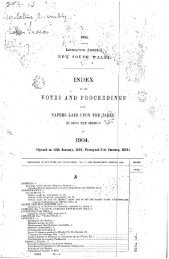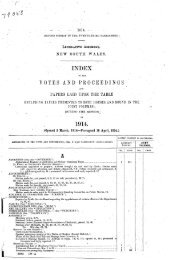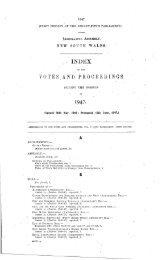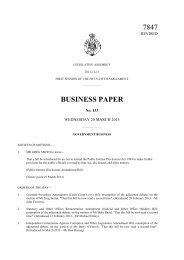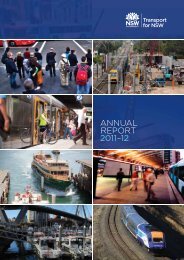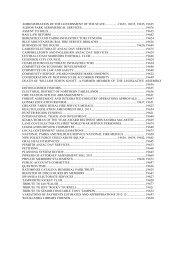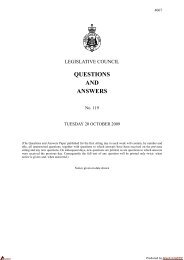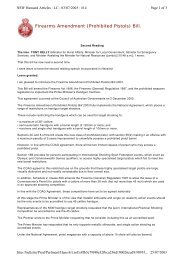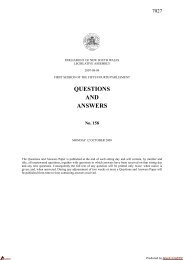Endeavour Energy Annual Performance Report - Parliament of New ...
Endeavour Energy Annual Performance Report - Parliament of New ...
Endeavour Energy Annual Performance Report - Parliament of New ...
Create successful ePaper yourself
Turn your PDF publications into a flip-book with our unique Google optimized e-Paper software.
2 Statement <strong>of</strong> Significant<br />
Accounting Policies<br />
continued<br />
AASB 2010-6 Amendments to<br />
Australian Accounting Standards –<br />
Disclosures on Transfers <strong>of</strong> Financial<br />
Assets – Effective 1 July 2011<br />
AASB 2010-7 Amendments to<br />
Australian Accounting Standards<br />
arising from AASB 9 (Dec 2010) –<br />
Effective 1 January 2013<br />
AASB 2010-8 Amendments to<br />
Australian Accounting Standards –<br />
Deferred Tax: Recovery <strong>of</strong> Underlying<br />
Assets – Effective 1 January 2012<br />
These Standards and associated<br />
amendments are not expected<br />
to have a material impact on<br />
the financial statements, except<br />
for changes associated with<br />
AASB 1053 and AASB 2010-2<br />
which are expected to significantly<br />
reduce disclosure requirements<br />
when adopted.<br />
(d) Use <strong>of</strong> estimates and<br />
judgements<br />
The preparation <strong>of</strong> financial<br />
statements in conformity with<br />
AASBs requires management<br />
to make judgements, estimates<br />
and assumptions that affect the<br />
application <strong>of</strong> accounting policies<br />
and the reported amounts <strong>of</strong> assets,<br />
liabilities, income and expenses.<br />
Actual results may differ from<br />
these estimates.<br />
Estimates and underlying<br />
assumptions are reviewed on<br />
an ongoing basis. Revisions<br />
to accounting estimates are<br />
recognised in the period in which<br />
the estimates are revised and in<br />
any future periods affected.<br />
Information about critical<br />
judgements in applying<br />
accounting policies that have<br />
the most significant effect on<br />
the amounts recognised in<br />
the financial statements, and<br />
information about assumptions<br />
and estimation uncertainties that<br />
have a significant risk <strong>of</strong> resulting<br />
in a material adjustment within the<br />
next financial year, is included in<br />
the following notes:<br />
Note 2(t) – Unread Meters<br />
Note 12 – Property, Plant and<br />
Equipment – Revaluations<br />
Note 14(h) – Employee Benefits<br />
Superannuation – Valuation Method<br />
and Principal Economic Assumptions<br />
Note 18 – Provisions<br />
Note 21 – Financial Instruments<br />
Note 22(b) – Contingent Liabilities<br />
(e) Contributed equity<br />
The State Owned Corporations<br />
Act 1989 (as amended) requires<br />
<strong>Endeavour</strong> <strong>Energy</strong> to have two<br />
voting shareholders. Current<br />
shareholders are the <strong>New</strong> South<br />
Wales Treasurer and the Minister<br />
for Finance who hold the shares on<br />
behalf <strong>of</strong> the NSW Government.<br />
Each shareholder holds one $1 share,<br />
with each share being <strong>of</strong> the same<br />
class with equal rights.<br />
(f) Foreign currency<br />
translation<br />
Both the functional and presentation<br />
currency <strong>of</strong> <strong>Endeavour</strong> <strong>Energy</strong> is<br />
Australian dollars (A$).<br />
Transactions in foreign currencies<br />
are initially recorded in the functional<br />
currency at the exchange rates at<br />
the date <strong>of</strong> the transaction. At each<br />
balance sheet date, monetary items<br />
denominated in foreign currencies<br />
are retranslated at the rates<br />
prevailing on the balance sheet date.<br />
Any foreign currency income or<br />
expense items are translated at<br />
exchange rates as at the date <strong>of</strong><br />
the transaction, with resulting<br />
exchange differences recognised<br />
as income or expense in pr<strong>of</strong>it or<br />
loss. Any foreign currency assets or<br />
liabilities are translated at exchange<br />
rates prevailing on the balance<br />
sheet date, with resulting exchange<br />
differences classified as equity and<br />
transferred to the foreign currency<br />
translation reserve.<br />
(g) Cash and cash equivalents<br />
Cash and cash equivalents in the<br />
Statement <strong>of</strong> Financial Position<br />
comprise cash at bank and in<br />
hand, short-term deposits readily<br />
convertible to cash, investments for<br />
a fixed term where the maturity date<br />
is three months or less from year end<br />
balance date, and readily tradeable<br />
investments which are likely to<br />
be converted to cash within three<br />
months <strong>of</strong> year end balance date<br />
even though the maturity date may<br />
be greater than three months from<br />
year end balance date.<br />
(h) Trade and other<br />
receivables<br />
Trade and other receivables are<br />
financial assets recognised initially<br />
at fair value plus any directly<br />
attributable transaction costs.<br />
Subsequent to initial recognition<br />
receivables are measured at<br />
amortised cost using the effective<br />
interest rate method, less any<br />
impairment losses.<br />
Collectibility <strong>of</strong> trade receivables<br />
is reviewed on an ongoing basis.<br />
Individual debts that are known to<br />
be uncollectible are written <strong>of</strong>f when<br />
identified. An impairment provision<br />
is recognised when there is objective<br />
evidence that the entity will not<br />
be able to collect the receivable.<br />
Financial difficulties <strong>of</strong> the debtor,<br />
default payments or debts more than<br />
120 days overdue are considered<br />
objective evidence <strong>of</strong> impairment.<br />
The amount <strong>of</strong> the impairment loss<br />
is the receivable carrying amount<br />
compared to the present value<br />
<strong>of</strong> estimated future cash flows,<br />
discounted at the original effective<br />
interest rate.<br />
<strong>Endeavour</strong> <strong>Energy</strong> <strong>Annual</strong> <strong>Performance</strong> <strong>Report</strong> 2010–11<br />
55



